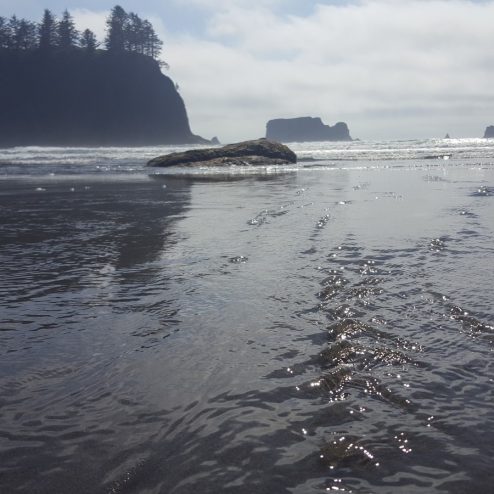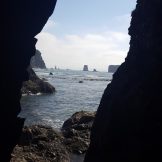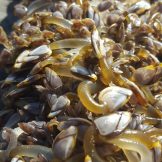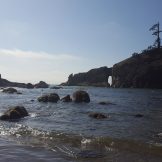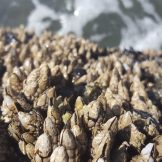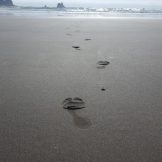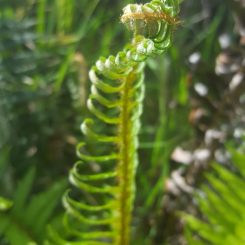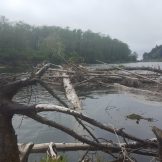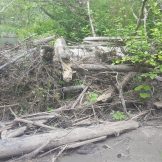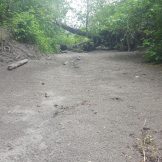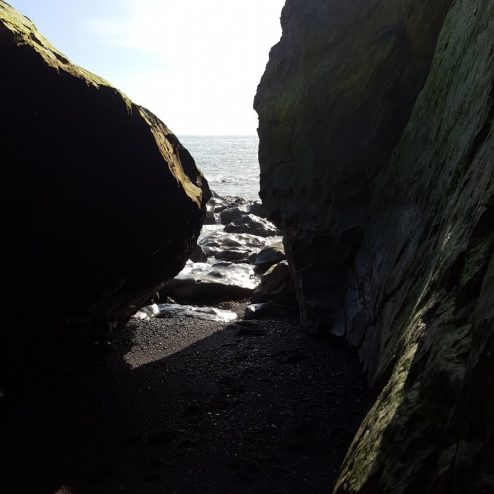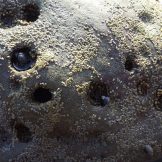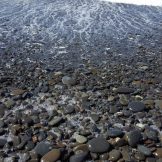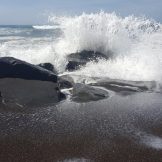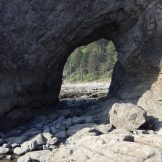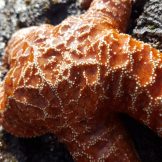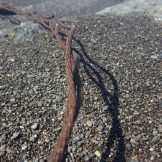Second Beach
Geology
The pacific coast is one on the most interesting and complicated geological sites in the world. This is because of the Juan de Fuca plate is colliding with North America creating the beautiful beaches we all know and love. However, these beautiful beaches hold the secrets of the past and future.
- Grain size: Throughout Second beach the grain size was fine or sand-sized. This means the energy level of the water is much lower and consentient then Rialto. The sand also has a pinkish tint because it is having bits of garnet (a heavy mineral brought down by old glacier deposits inland) deposited on the beach.
- Arch: arches are formed when wave action repeatedly carve out a crack in the rock and creates a cave over time. The cave in the continuously eroded away leaving the arch way. This arch is similar to the one at Raito however it is much larger and closer to collapsing and becoming a stack. It is also cannot be walked though at low tides like the Hole in the Wall at Rialto.
- Tide pools: There are no true tide pools at Second Beach, however there is the start of them. Tide pools are formed stacks collapse into stumps and then are eventually eroded into a wave cute platform. The water carves out the weak spots in the rocks leaving then doted with various size holes. At second beach you can see the waters starting to erode away the rock into a wave cute platform at the north end of the beach.
- Rock type: Second beaches most interesting geological factor is the large block of volcanic rock rests on the beach near the entrance of the tail. This is very usual in costal areas and is only found in mélange rock zones. This large volcanic rock and the smaller ones half a mile up the beach are made up of angular fragments of volcanic rock and some sedimentary rocks that are stuck together to form a breccia with some veins of calcite scattered throughout the rock from secondary mineralization. I was unable to identify some of the other rocks on the beach however they seemed to be iron and calcium rich.
- Stacks: Stacks are formed from arches when they collapse and leave the stack standing. There are many more stacks on second beach then there were on Rialto. I was unable to identify the rock type of any of the stacks because there were all to far into the water.
- Past and future of Second Beach: the many stacks show that the coast line was once farther out, similar to Rialtos cost line. In the future the water level will rise and cause it to enter and erode the part of the forest. This will live many dead trees and logs scattered on the new beach.
United States. National Park Service. “Washington DNR: Washington Coastal Geology between the Hoh and Quillayute Rivers (Part II).” National Parks Service. U.S. Department of the Interior. Web. 28 Apr. 2016.
Dickey River
Geology
The pacific coast is one on the most interesting and complicated geological sites in the world. This is because of the Juan de Fuca plate is colliding with North America creating the beautiful beaches we all know and love. However, these beautiful areas hold the secrets of the past and future.
- Grain Size: the area of dickey river we observed was relatively low energy meaning that there were finer sediments deposited. A mix of sand silt and clay called loam was found around dickey river. In the water itself there were some larger stones along with with loam deposits.
- River Path: Rivers regally change their paths for a variety of reasons such a flooding, log jams, human influence and more. While exploring the area around rive we found an old river path. It was now dried up and looked to have been forced to change paths because of a log jam.
- Past and future of Dickey River: In the past the river was most likely following a different path that today is now dried up and unrecognizable as a prior river path. In the future the current river path will be most likely jammed by various debris again and forced to find a new path.
Rialto
Geology
The pacific coast is one on the most interesting and complicated geological sites in the world. This is because of the Juan de Fuca plate is colliding with North America creating the beautiful beaches we all know and love. However, these beautiful beaches hold the secrets of the past and future.
- The Jetty: The river that spills into the ocean near rialto beach once went threw the area that is now for parking. It has had many different paths over time and once it migrated to La Push harbor the jetty or dike was put in to create a calm “lagoon”. The jetty is a man made structure and the rocks used to make it were quarried from the Hoh sandstone and conglomerate exposed on the north side of Quateata at the south end of First Beach.
- Grain size: Throughout Rialto Beach the grain size of the sediment had a wide range of variation. It went from sand size grains to pebbles to large stones. This could be seen walking from the waterline up the steep gradient of the beach towards the forest as well as walking down the beach from the jetty to the tide pools or visa versa. The grain size is determined by the energy level of the water. High energy equals larger stones and low energy equals fine sediments such as sand. The fluctuations in grain size this means there are fluctuations in the waters energy level. Based off my observations of the coast I noticed the fine sediments were found when the coast curved in and the larger sediments were found were the coast was curved out of straight. I theorize that the areas curved in created a type of underwater barrier or protection against the water which lowered the waters energy and allowed the fine sediments to settle which in turn created the strange grain size fluctuation on the beach.
- Hole in the Wall: One the greatest attractions to Rialto beach is Hole in the Wall an arch that at low tides one can walk through. These are formed when wave action repeatedly carve out a crack in the rock and creates a cave over time. The cave in the continuously eroded away leaving the arch way. Hole in the Wall particularly interesting because the waves carved away the rock exposing a twisted line in the rock on the inside of hole in the wall. This line in the rock is the rock metamorphosing from sandstone to quartzite. This is caused by heat and pressure from the rocks above and below it.
- Stacks: On Rialto Beach many stacks near and far were visible. Stacks are formed from arches when they collapse and leave the stack standing. I was able to observe one stack close up and determined it was made of sandstone.
- Tide Pools: The tide pools on Rialto are home to many creatures. Tide pools are formed when stacks collapse into stumps and then are eventually eroded into a wave cute platform. The water carves out the weak spots in the rocks leaving then doted with various size holes. These holes then proved protection and life to many creatures that need to attach to a hard substrate.
- Past and future of Rialto: In the past the coast line of rialto was farther out. I can make this assumption because the stacks that are far out in the water. This must have been the old coast line. In the future the water line will rise and without the curves on the beach it will cause it to be high energy resulting in a rocky beach with a steep gradient.
“Rialto Beach.” AllTrips. Web. 28 Apr. 2016.
United States. National Park Service. “Washington DNR: Washington Coastal Geology between the Hoh and Quillayute Rivers (Part II).” National Parks Service. U.S. Department of the Interior, 28 Mar. 2006. Web. 28 Apr. 2016.
Map
by Randa, Randoff, Ali, and Marissa
